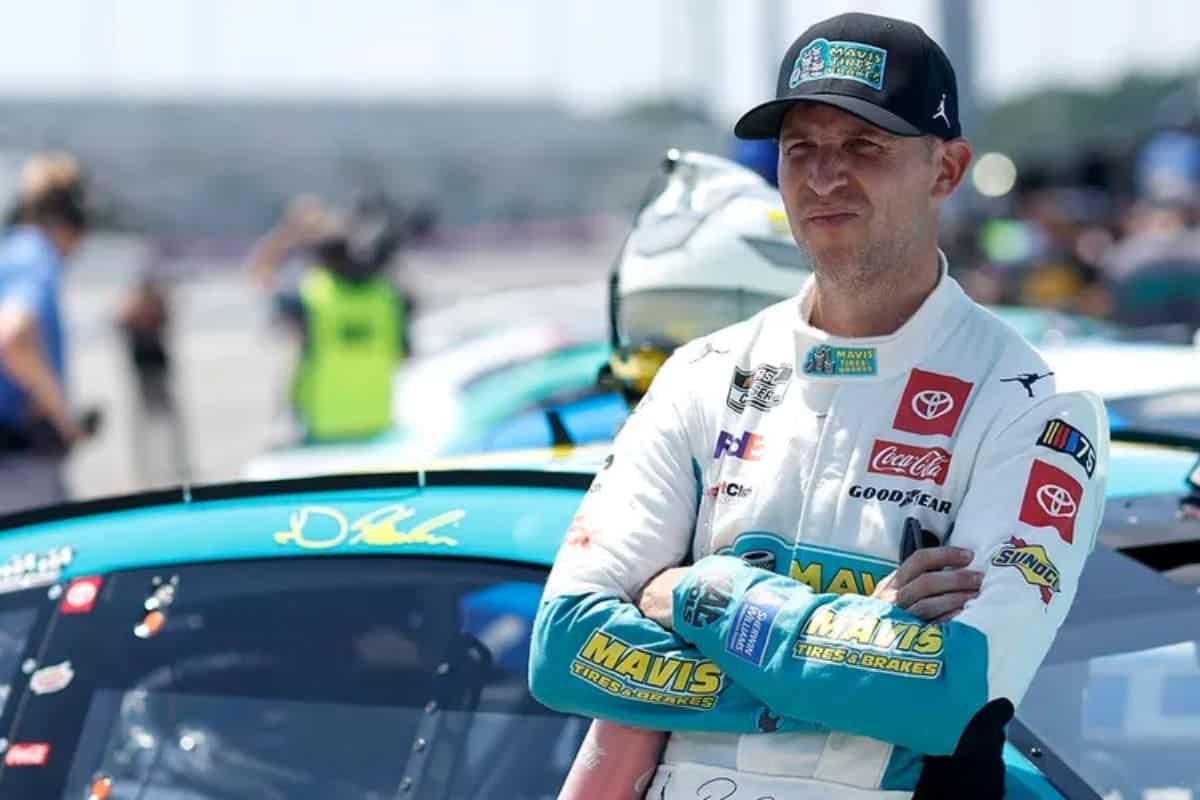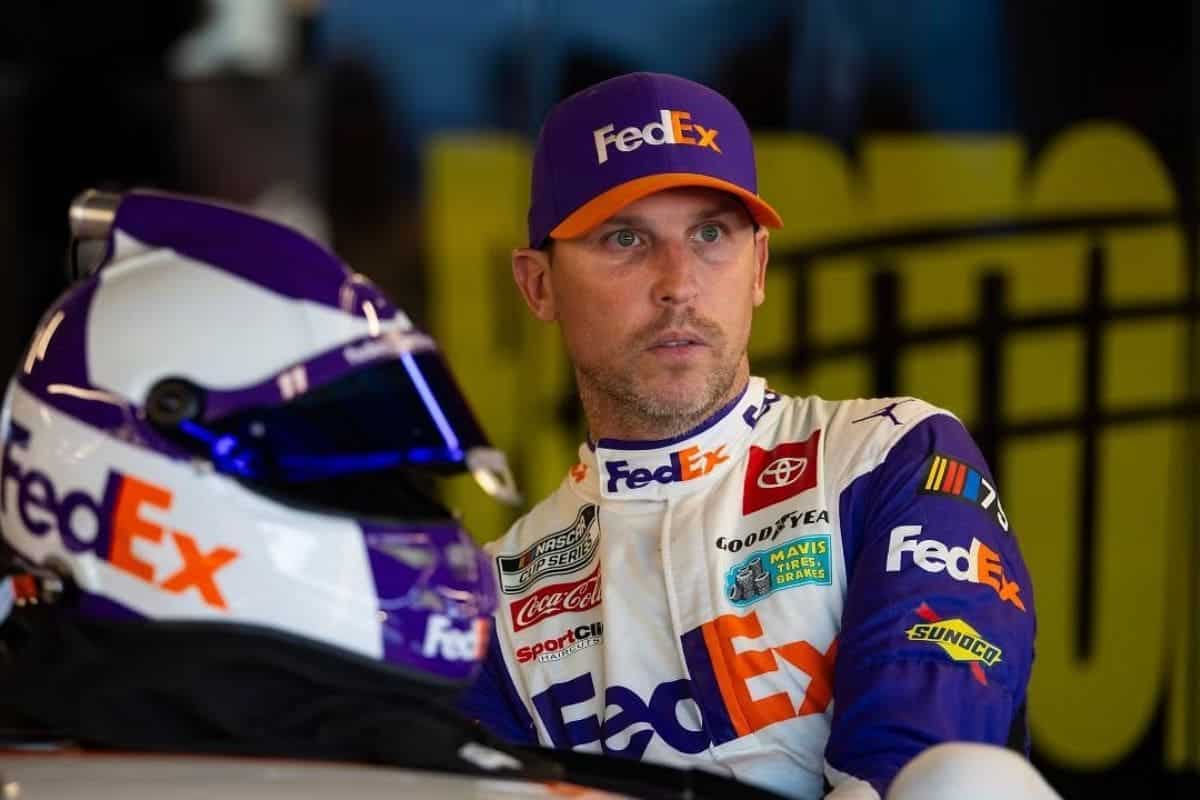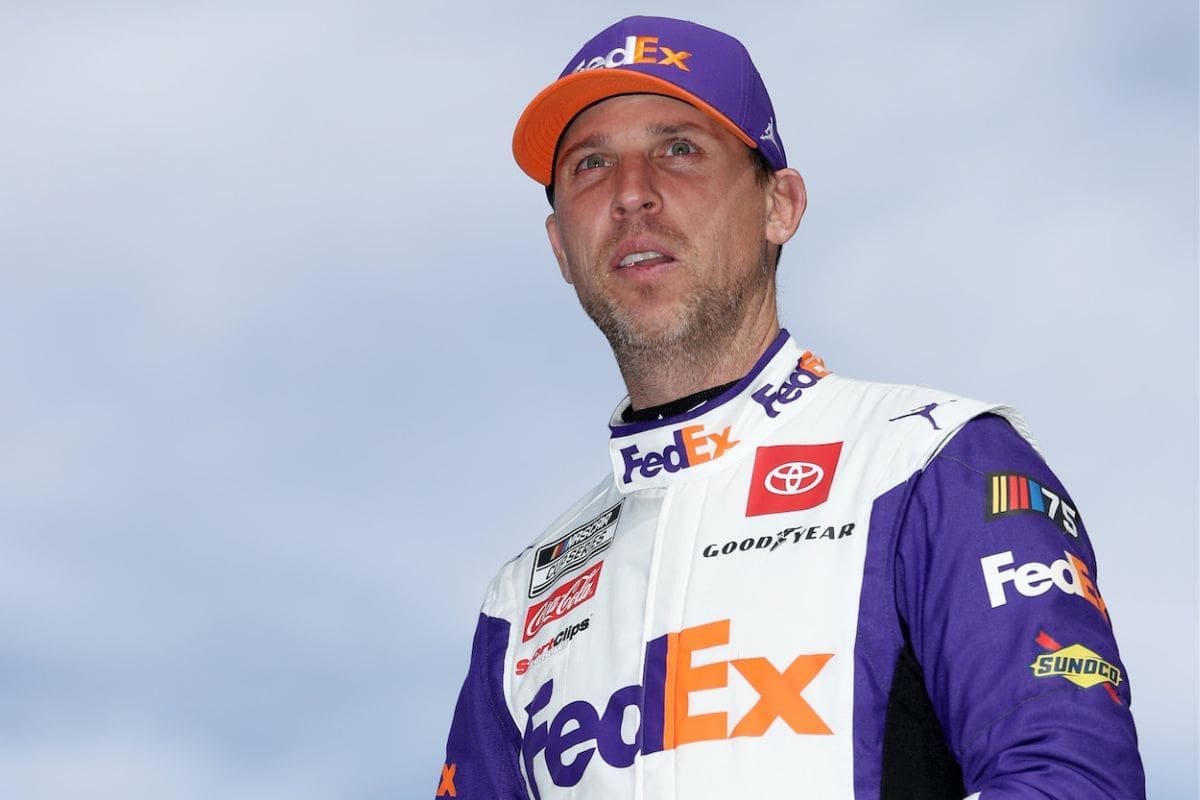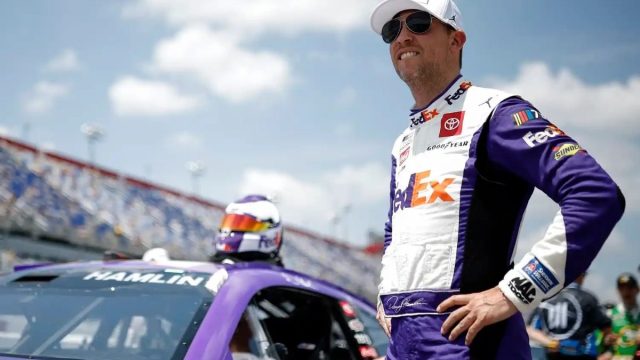Denny Hamlin Urges Goodyear: Denny Hamlin, a seasoned NASCAR driver, has publicly expressed his concerns over the sport’s trajectory, emphasizing the detrimental impact of enforced parity on competition and strategic diversity. He has spotlighted Goodyear’s critical role in this dynamic, urging the tire giant to lead efforts in directing NASCAR’s focus toward performance and tire management. By demanding for a shift away from overly standardized competition, Hamlin highlights the need for a balance that fosters competitive fairness and strategic depth. This call to action shows the complexity of maintaining NASCAR’s core essence while evolving to enhance engagement and competitiveness.
Key Takeaways
- Denny Hamlin criticizes NASCAR’s parity policy, claiming it limits strategic diversity and competitive edge.
- Hamlin suggests Goodyear could play a pivotal role in enhancing NASCAR’s racing dynamics through tire innovation.
- The veteran driver emphasizes the importance of performance and tire management in reviving NASCAR’s competitiveness.
- Hamlin calls for a reassessment of NASCAR’s regulatory approach to allow for more innovation within safety and fair play.
- By urging Goodyear to aid in this transformation, Hamlin aims to mitigate frustration among drivers and fans.
NASCAR’s Evolution
Over its 76-year glorious history, NASCAR has experienced significant evolutionary changes, fundamentally altering the sport of stock car racing. The entry of corporate businessmen in the 1980’s marked a pivotal turn, drawing NASCAR away from its roots of raw creativity and individual flair towards a model of standardized competition. This period saw the introduction of parity across all race cars, a concept designed to level the playing field but which also suppressed innovation. Drivers, who had once relied on their ingenuity and mechanical prowess to gain an edge, found themselves adapting to a new era where their success was less dependent on personal skills and more on the capabilities of their team and the specifications set by the organization.
The shift towards parity was accompanied by the implementation of steady salaries for drivers, a move that further showed NASCAR’s transformation into a more corporate and structured entity. This change was double-edged; while it provided financial stability for drivers, it also diluted the fierce independence that had characterized stock car racing’s early days. The essence of competition was subtly redefined, prioritizing consistency and adherence to regulations over the daring and innovation that had once defined the sport.
This evolution of NASCAR, from a bold, high-octane showcase of individual talent to a tightly regulated spectacle of corporate interests, reflects broader trends in professional sports. It speaks to the balancing act between preserving the unpredictable, thrilling nature of competition and the desire for a level playing field that is fair and commercially viable. As NASCAR continues to navigate these waters, the challenge remains to honor its heritage while adapting to the demands of a changing sports landscape.

Drivers’ Critique of Parity
Amidst the evolving landscape of NASCAR, a chorus of veteran drivers, including Geoff Bodine and Denny Hamlin, have voiced their concerns over the organization’s strict pursuit of parity, arguing that it may have tipped the scales too far from the sport’s original spirit of innovation and individual prowess. The shift towards equalizing the competition has sparked a heated debate on whether NASCAR is losing its essence, favoring uniformity over the unique engineering and strategic variations that once defined the racing experience.
The drivers’ critique of this enforced parity highlights several key issues:
- Diminished Individuality: The push for parity risks homogenizing teams and drivers, suppressing the creativity and engineering marvels that have historically set competitors apart. The essence of racing, as voiced by veterans like Bodine, lies in the freedom to innovate within the bounds of safety and fair play.
- Restrained Competitive Spirit: By leveling the playing field too rigorously, NASCAR might be accidentally dampening the competitive spirit that fuels all the drivers and engineers. The thrill of outpacing rivals through superior strategy, skill, and innovation is at risk of being overshadowed by regulatory constraints.
- Fan Engagement: The uniqueness and diversity of teams and cars play a significant role in attracting and retaining fans. A too-strict approach to parity could lead to a homogenized field, potentially dulling the spectacle and diminishing fan engagement.

Denny Hamlin’s Discontent
Denny Hamlin has voiced his frustration with the current state of NASCAR, emphasizing the detrimental effects of enforced equality on track dynamics and competition. His grievances show a broader issue within the sport – the quest for parity has accidentally led to a homogenized racing experience. By scrutinizing every vehicle for the slightest disparities, NASCAR has fostered an environment where pack racing prevails, stripping away the variations that once characterized the sport.
The heart of Hamlin’s discontent lies in the belief that this enforced equality has eroded the competitive edge that drivers and teams work tirelessly to achieve. The meticulous examination of vehicles for any minor variance has, according to Hamlin, diverted from the sport’s essence, transforming races into a predictable procession rather than a showcase of skill and strategy.
Hamlin’s critique extends beyond mere dissatisfaction; it is a clear call for NASCAR to reassess its approach to regulation. By demanding for a reevaluation, Hamlin shows the need for a balance that respects the integrity of competition while ensuring fairness. His insights offer a roadmap for reviving NASCAR, suggesting that a distinct approach to regulation could revive the sport, enhancing its competitive essence and its appeal to fans.
We did it, folks. The closest race in #NASCAR history from 1st place to last place. I know the race was a banger for the majority of it, but this speaks to the parity of the field in the Cup Series these days. https://t.co/dsBxqjdhAe
— Toby Christie (@Toby_Christie) April 1, 2024
Hamlin’s Criticism of Parity Policy
In his critique of NASCAR’s parity policy, Hamlin highlights a moment on the track with his JGR teammate, Martin Truex Jr., that represents the broader issues plaguing the sport’s competitive dynamics. This incident, involving a failed attempt to push the No. 22 car, serves as an example for the challenges drivers face under the current parity-driven framework. Hamlin’s experience, where strategic maneuvers are suppressed, and races become a matter of equalized lap times, shows the need for a reevaluation of NASCAR’s regulatory approach.
Hamlin’s not the only one raising eyebrows at NASCAR’s “equal racing” approach. Just weeks ago, he was quick to note the lack of passing action at Phoenix, where drivers seemed stuck in a time warp, driving out identical lap times. And he’s not alone in his critique. Kyle Busch, representing RCR, echoed similar sentiments earlier this year.
- Strategic Limitations: The incident described by Hamlin illustrates how the parity policy can limit strategic diversity on the track. When cars are so evenly matched that attempts at strategic advantage quickly lead to a stalemate, the sport risks losing the dynamic competition that fuels fan interest and driver ambition.
- Heat Management Issues: Hamlin’s reference to everything getting ‘hot’ and the consequent cessation of his run highlights a technical challenge inherent in the current setup. This emphasizes the need for a balance between competitive parity and the mechanical flexibility required to manage the physical stresses of racing.
- Equalized Performance: The most important aspect of Hamlin’s criticism is the notion of equalized lap times. While parity aims to level the playing field, there’s a fine line between ensuring competitive fairness and homogenizing the sport to the point where individual skill and strategic ingenuity are overshadowed by regulations.
“Everything got hot, and then it was over. The run stopped. We all equalized in the same lap time.”
“So if you had more tire wear, it’s been proven, we’ve seen what tire wear does at Bristol. It creates huge disparities in speeds. I think that Goodyear’s trying, they keep coming back with more gage, more heat…They need to get way more aggressive than what they’ve got. This Phoenix/Richmond tire needs to be considerably more softer than what it is.” – (Denny)
Bodine’s Reflection and Call for Change
Reflecting on his extensive career, 18-time Cup winner Geoff Bodine highlighted the detrimental effects of excessive parity in NASCAR, urging for a shift towards more performance-based outcomes that prioritize tire management. Bodine, drawing on his years of experience, pointed out the significant contrast between the racing landscape of his era and the current state, where the drive towards equalizing competition seems to have overshadowed the essence of racing that once celebrated the combination of driver skill, strategic pit stops, and the essential role of tire management.
Geoff Bodine, a seasoned racer with over three decades of experience, reminisces about a pivotal shift in NASCAR’s landscape back in the 1980’s. He recalls a time when NASCAR fell under the grip of corporate influence, marking a turning point in the sport’s dynamics. With cars becoming more uniform and drivers securing steady salaries, the pressure to perform solely based on finishing positions eased off. This newfound stability seemingly unleashed a wave of aggression on the track, fundamentally altering the nature of NASCAR competition.

The call for change by veterans like Bodine and Hamlin pivots around the belief that the sport’s authorities, including tire suppliers like Goodyear, should recalibrate their focus towards fostering a racing environment where performance and tire management are pivotal. Such a shift, as witnessed during the Bristol race, not only challenges drivers and teams to excel in these critical areas but also promises to revive the strategic depth that once defined NASCAR. The push towards performance-based outcomes, showed by a distinct understanding of tire management, stands as a proof to the belief in the sport’s ability to evolve while preserving the core of what makes NASCAR uniquely captivating.
“We’d still bump, but we didn’t wreck,” Bodine said. “As soon as we got the salaries, then the wrecking started. You made more money out of a salary than racing. They still all want to finish, but they’ve been told to drive it as hard as it will go. They’re good and they drive hard. I wouldn’t want to be out there with them. They’re crazy.”
News in Brief
The ongoing debate around NASCAR’s parity policy, as highlighted by Denny Hamlin’s vocal criticism, shows a critical period in the sport’s evolution. Hamlin’s discontent, echoing broader driver frustrations, presents a compelling argument for reconsideration of Goodyear’s role in ensuring competitive equity.
Reflecting on Bodine’s insights, it becomes apparent that a reevaluation of policies might be imperative to preserving NASCAR’s integrity and fostering an environment where skill and strategy outweigh the homogenization of competition, thereby safeguarding the sport’s future.
Our Reader’s Queries
Q: Has Denny Hamlin ever won a road race?
A: Hamlin clinched his first road course victory by leading just 10 laps of the 90-lap race, showcasing his strategic prowess as he seized the most crucial moments at the end.
Q: How rich is Hamlin?
A: According to Celebrity Net Worth, Denny Hamlin’s net worth stands at $65 million. This figure comprises earnings from races, sponsorships such as his long-standing partnership with FedEx, Coca-Cola, and Nike Jordan, as well as potential gains from the increased value of NASCAR charters.
Q: Does NASCAR still use Goodyear tires?
A: In 2022, Goodyear reaffirmed its exclusive tire partnership with NASCAR’s top three national series, underscoring its dedication to ongoing innovation for the next generation of drivers. As one of the world’s largest tire companies, Goodyear remains integral to the sport’s success.
Also Read:Denny Hamlin’s Revealing Chat with Truex Jr.: Inside Their Post-Race Drama!
